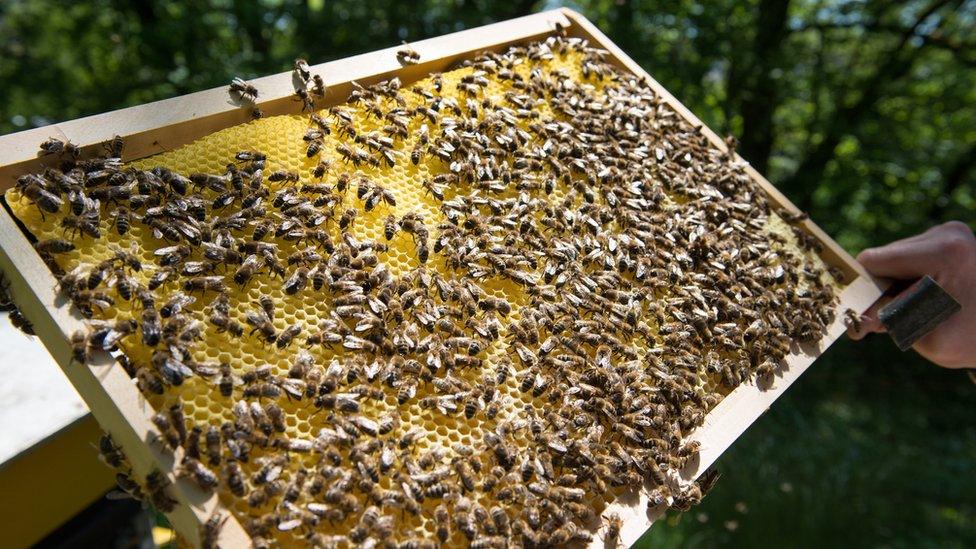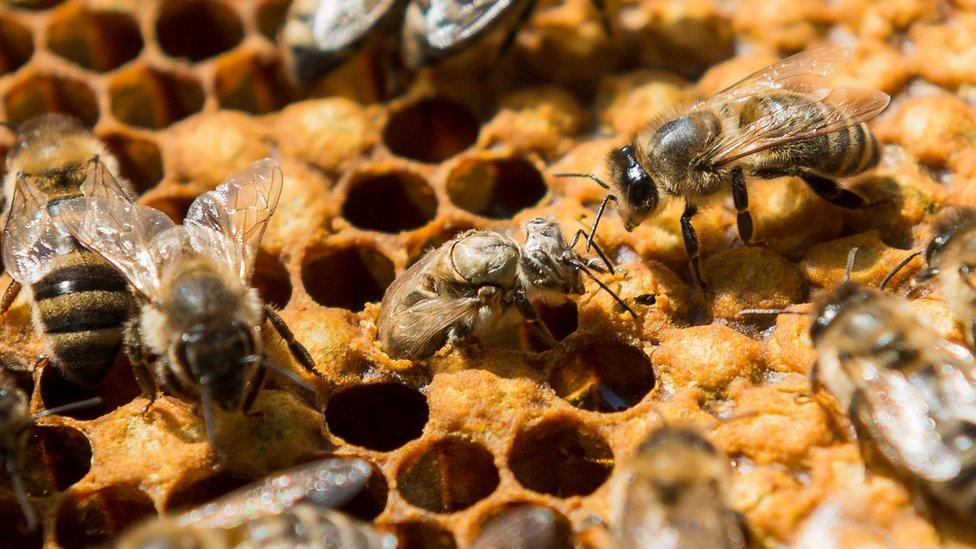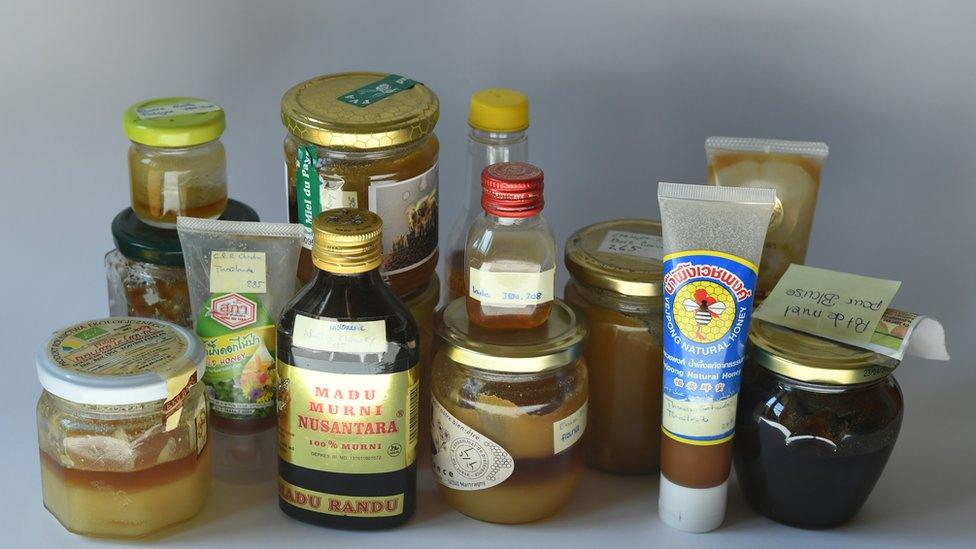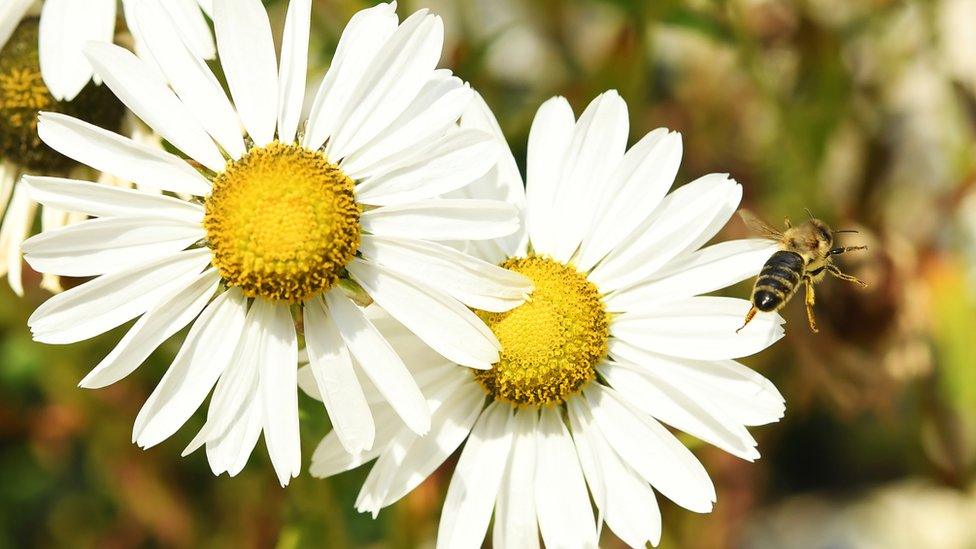Pesticides linked to bee deaths found in most honey samples
- Published

Three quarters of the honey samples in this study showed traces of neonicotinoids
A new study has found traces of neonicotinoid chemicals in 75% of honey samples from across the world.
The scientists say that the levels of the widely used pesticide are far below the maximum permitted levels in food for humans.
In one-third of the honey, the amount of the chemical found was enough to be detrimental to bees.
Industry sources, though, dismissed the research, saying the study was too small to draw concrete conclusions.
Neonicotinoids are considered to be the world's most widely used class of insecticides.

The findings showed levels of chemicals detrimental to bees in about a third of the samples
These systemic chemicals can be added as a seed coating to many crops, reducing the need for spraying. They have generally been seen as being more beneficial for the environment than the older products that they have replaced.
However, the impact of neonics on pollinators such as bees has long been a troubling subject for scientists around the world. Successive studies have shown a connection between the use of the products and a decline in both the numbers and health of bees.
Earlier this year, the most comprehensive field study to date concluded that the pesticides harm honey bees and wild bees.
This new study looks at the prevalence of neonicotinoids in 198 honey samples gathered on every continent (except Antarctica).
The survey found at least one example of these chemicals in 75% of the honey, from all parts of the globe. Concentrations were highest in North America, Asia and Europe.

Honey samples from all over the world were examined
The European finding is a puzzle as there has been a ban on the use of these products in place since 2013.
The authors believe though that the finding should not be a worry to people who eat honey.
"It is well below the limit so I think it is not a major public health concern," author Dr Alexandre Aebi from the University of Neuchatel in Switzerland, told BBC News.
"We would have to eat an awful lot of honey and other contaminated products to see an effect, but I think it's a warning and it is a call for a precautionary principle. Neonics have just been shown to be endocrine perturbators for honey bees, so who knows?"
The bigger concern according to Dr Aebi was the impact on bees and other pollinators. Some 34% of the honey samples showed the presence of neonics at levels that would harm bees.
Of particular concern to the authors was the cocktail effect, the mixing of two or more neonicotinoids found in 45% of the samples.
"It is definitely scary for honeybees and other bees and useful insects," he said.
"We have up to five molecules in one single sample. From a risk assessment point of view, the evaluation of the risk is made from one single compound in one test organism. So the cocktail is not tested. Mixed effects should be taken seriously."

The authors believe that a ban on neonicotinoids is the most effective solution
The scientists were not able to distinguish between organic and other honey samples in their research. Others in the field agree that the new study asks some serious questions about the widespread impact of these chemicals, on all forms of honey.
"Neonicotinoids are highly persistent in the environment, and frequently turn up in soils, water samples, and in wildflowers, so we would expect to find them in honey," said Dave Goulson, professor of biology at the University of Sussex, who was not involved in the study.
"Entire landscapes all over the world are now permeated with highly potent neurotoxins, undoubtedly contributing to the global collapse of biodiversity. Some of us have been pointing this out for years, but few governments have listened."
Industry figures though are critical of the study pointing out that it is hard to draw conclusions from just 200 hundred samples.
"Setting aside the sample size of the study not being large enough to be representative, the fact that a residue is found is not in itself a cause for concern," said Graeme Taylor, director of public affairs at the European Crop Protection Association, which represents the manufacturers of neonics.
"In relation to the findings of the study more specifically, the reported residue levels are miniscule and well below human safety limits."
The authors of the new study believe that a permanent ban, as proposed in France, is the best solution.
Dr Aebi is an amateur beekeeper whose own honey was analysed in the study. He believes that restrictions on eating honey, contaminated with neonics or not, aren't justified at present.
"My own honey was contaminated by three neonicotinoids, in trace amounts. I still eat it. I still give it to my kids."
The study has been published in the journal, external Science.
Follow Matt on Twitter, external and on Facebook, external